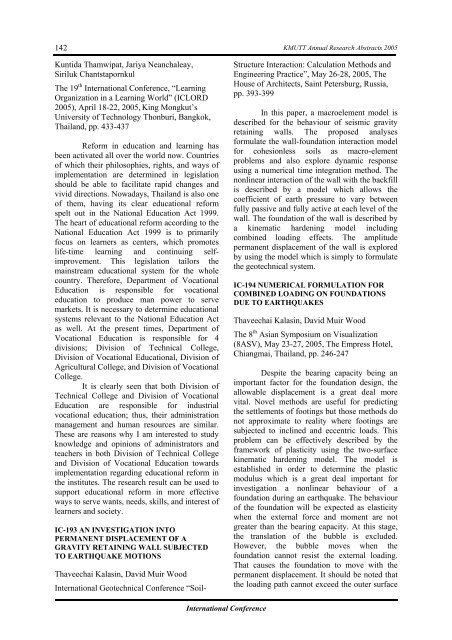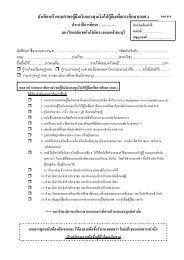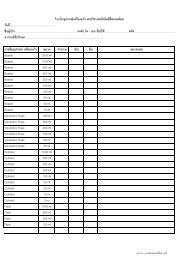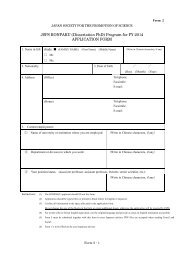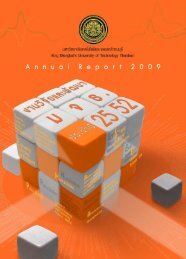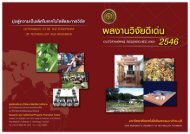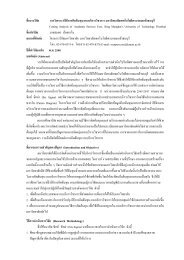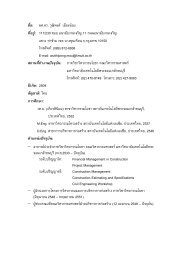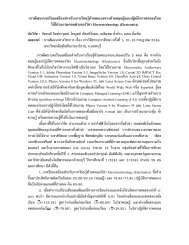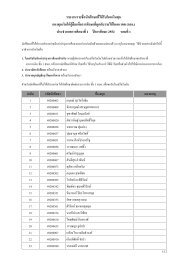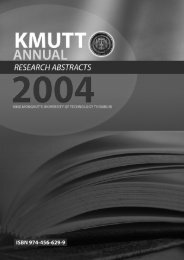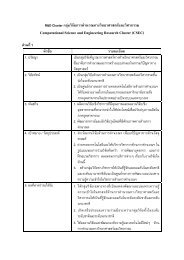Create successful ePaper yourself
Turn your PDF publications into a flip-book with our unique Google optimized e-Paper software.
142<br />
Kuntida Thamwipat, Jariya Neanchaleay,<br />
Siriluk Chantstapornkul<br />
The 19 th International Conference, “Learning<br />
Organization in a Learning World” (ICLORD<br />
2005), April 18-22, 2005, King Mongkut’s<br />
University of Technology Thonburi, Bangkok,<br />
Thailand, pp. 433-437<br />
Reform in education and learning has<br />
been activated all over the world now. Countries<br />
of which their philosophies, rights, and ways of<br />
implementation are determined in legislation<br />
should be able to facilitate rapid changes and<br />
vivid directions. Nowadays, Thailand is also one<br />
of them, having its clear educational reform<br />
spelt out in the National Education Act 1999.<br />
The heart of educational reform according to the<br />
National Education Act 1999 is to primarily<br />
focus on learners as centers, which promotes<br />
life-time learning and continuing selfimprovement.<br />
This legislation tailors the<br />
mainstream educational system for the whole<br />
country. Therefore, Department of Vocational<br />
Education is responsible for vocational<br />
education to produce man power to serve<br />
markets. It is necessary to determine educational<br />
systems relevant to the National Education Act<br />
as well. At the present times, Department of<br />
Vocational Education is responsible for 4<br />
divisions; Division of Technical College,<br />
Division of Vocational Educational, Division of<br />
Agricultural College, and Division of Vocational<br />
College.<br />
It is clearly seen that both Division of<br />
Technical College and Division of Vocational<br />
Education are responsible for industrial<br />
vocational education; thus, their administration<br />
management and human resources are similar.<br />
These are reasons why I am interested to study<br />
knowledge and opinions of administrators and<br />
teachers in both Division of Technical College<br />
and Division of Vocational Education towards<br />
implementation regarding educational reform in<br />
the institutes. The research result can be used to<br />
support educational reform in more effective<br />
ways to serve wants, needs, skills, and interest of<br />
learners and society.<br />
IC-193 AN INVESTIGATION INTO<br />
PERMANENT DISPLACEMENT OF A<br />
GRAVITY RETAINING WALL SUBJECTED<br />
TO EARTHQUAKE MOTIONS<br />
Thaveechai Kalasin, David Muir Wood<br />
International Geotechnical Conference “Soil-<br />
KMUTT Annual Research Abstracts 2005<br />
Structure Interaction: Calculation Methods and<br />
Engineering Practice”, May 26-28, 2005, The<br />
House of Architects, Saint Petersburg, Russia,<br />
pp. 393-399<br />
In this paper, a macroelement model is<br />
described for the behaviour of seismic gravity<br />
retaining walls. The proposed analyses<br />
formulate the wall-foundation interaction model<br />
for cohesionless soils as macro-element<br />
problems and also explore dynamic response<br />
using a numerical time integration method. The<br />
nonlinear interaction of the wall with the backfill<br />
is described by a model which allows the<br />
coefficient of earth pressure to vary between<br />
fully passive and fully active at each level of the<br />
wall. The foundation of the wall is described by<br />
a kinematic hardening model including<br />
combined loading effects. The amplitude<br />
permanent displacement of the wall is explored<br />
by using the model which is simply to formulate<br />
the geotechnical system.<br />
IC-194 NUMERICAL FORMULATION FOR<br />
COMBINED LOADING ON FOUNDATIONS<br />
DUE TO EARTHQUAKES<br />
Thaveechai Kalasin, David Muir Wood<br />
The 8 th Asian Symposium on Visualization<br />
(8ASV), May 23-27, 2005, The Empress Hotel,<br />
Chiangmai, Thailand, pp. 246-247<br />
Despite the bearing capacity being an<br />
important factor for the foundation design, the<br />
allowable displacement is a great deal more<br />
vital. Novel methods are useful for predicting<br />
the settlements of footings but those methods do<br />
not approximate to reality where footings are<br />
subjected to inclined and eccentric loads. This<br />
problem can be effectively described by the<br />
framework of plasticity using the two-surface<br />
kinematic hardening model. The model is<br />
established in order to determine the plastic<br />
modulus which is a great deal important for<br />
investigation a nonlinear behaviour of a<br />
foundation during an earthquake. The behaviour<br />
of the foundation will be expected as elasticity<br />
when the external force and moment are not<br />
greater than the bearing capacity. At this stage,<br />
the translation of the bubble is excluded.<br />
However, the bubble moves when the<br />
foundation cannot resist the external loading.<br />
That causes the foundation to move with the<br />
permanent displacement. It should be noted that<br />
the loading path cannot exceed the outer surface<br />
International Conference


